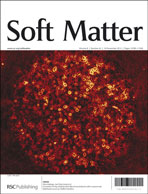Doubly crosslinked microgel–polyelectrolyte complexes: three simple methods to tune and improve gel mechanical properties†
Abstract
Doubly crosslinked microgels (DX MGs) are hydrogels composed of covalently interlinked microgels. They are injectable and have potential application in soft tissue repair. Simple methods for tuning their mechanical properties are required. Here, we investigate the effect of added polyelectrolyte (polycations or a polyanion) as well as NaCl on the mechanical properties of the gels for the first time. Addition of polycations improved ductility and decreased the storage modulus (G′) of the DX MG–polyelectrolyte complex (DX MG–PECs) gels. The best DX MG–PEC gel had a yield strain (γc) of 109%, which is the highest reported to date for any DX MG. Furthermore, our DX MG–PEC gels were robust and maintained high G′ values as well as good ductility when swollen at pH = 7.5. The DX MG–PEC gels with improved ductility contained less than 10% polycation. We also investigated the effect of addition of NaCl solution during DX MG and DX MG–PEC preparation. This caused remarkable increases in both G′ and ductility. The best gel had a G′ of 300 kPa which is the highest elasticity reported for a DX MG to date. Addition of linear polyacrylic acid during DX MG preparation also increased the G′ values. This study has provided three new simple methods for tuning the mechanical properties of DX MGs Because the MGs used here belong to a broad class of polymer colloids the results obtained in this study should be generally applicable.


 Please wait while we load your content...
Please wait while we load your content...